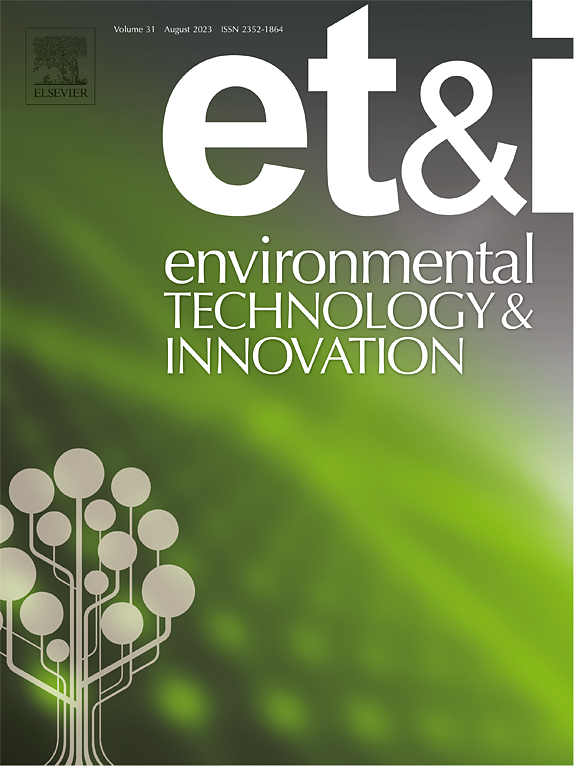草料植物管理对污染尾矿土的可持续修复:增强土壤功能和解决草料安全风险
IF 7.1
2区 环境科学与生态学
Q1 BIOTECHNOLOGY & APPLIED MICROBIOLOGY
引用次数: 0
摘要
尾矿污染土壤是一种未充分利用的土地资源,利用牧草对其进行开垦可以恢复景观,减轻金属污染,并支持植物修复。对污染尾矿土复垦的5种牧草进行了评价。所有禾草对Cd、Pb和Zn的生物浓度因子(BCF) <; 0.11 ± 0.02,表现出较强的适应性,这可能与它们的金属排斥特性有关。与裸地相比,草地复垦显著改善了土壤的多功能性,提高了土壤理化性质、酶活性、根际细菌α-多样性和生物量。此外,开垦草地重塑了微生物群落,朝着有利于植物的微生物群方向发展,包括氮循环细菌的富集(例如,含有nirK, nosZ基因的细菌增加)和共生菌根真菌的增加。温室试验进一步表明,根际自然恢复的微生物群落与已建立的AMF共生关系相似,提高了牧草的适应性。这些微生物群落促进了重金属在根系中的稳定,减少了金属转运,降低了食物链污染的风险,从而促进了植物的生长。我们的研究结果表明,这些自然恢复的微生物群应优先用于用牧草替代AMF的尾矿土复垦。然而,饲草中重金属污染的潜在风险需要仔细考虑,因为所调查的所有物种都有超过重金属限制的风险,除了P. purpureum 'Sweet',仍在青贮允许的水平内。将微生物重金属缓解与土壤改良剂等策略相结合,选择低金属积累的禾草,如P. purpureum 'Sweet,为严重污染的尾矿土壤的植物管理提供了一种有前途的、可持续的方法。本文章由计算机程序翻译,如有差异,请以英文原文为准。
Phytomanagement with forage grasses for sustainable remediation of contaminated tailings soil: Enhancing soil functionality and addressing forage safety risks
Tailings-contaminated soils represent an underutilized land resource, and reclaiming them with forage grasses can restore landscapes, mitigate metal pollution, and support phytoremediation. This study evaluates five forage grasses for reclamation in contaminated tailings soil. All grasses demonstrated strong adaptability, likely due to their metal exclusion traits, with bioconcentration factors (BCF) < 0.11 ± 0.02 for Cd, Pb, and Zn. Grass reclamation significantly improved soil multifunctionality, enhancing physicochemical properties, enzyme activities, and rhizosphere bacterial α-diversity and biomass compared with bare soil. Furthermore, grass reclamation reshaped the microbial community, towards a plant-beneficial microbiome, including the enrichment nitrogen-cycling bacteria (e.g., increased bacteria containing nirK, nosZ genes), and a rise in symbiotic mycorrhizal fungi. Greenhouse experiments further demonstrated that the microbial communities naturally restored in the rhizosphere, similar to those associated with established AMF symbioses, improved forage grass adaptability. These microbial communities facilitated heavy metal stabilization in roots, reduced metal translocation, and lowered the risk of food chain contamination, thereby promoting plant growth. Our results suggest that these naturally restored microbiotas should be prioritized in tailings soil reclamation with forage grasses as an alternative to AMF. However, the potential risk of heavy metal contamination in forage grasses requires careful consideration, as all species investigated pose a risk of exceeding heavy metal limits, except for P. purpureum 'Sweet', remaining within permissible levels for silage. Combining microbial heavy metal mitigation with strategies such as soil amendments and selecting low-metal-accumulating grasses, like, P. purpureum 'Sweet', provides a promising, sustainable approach for phytomanagement of severely contaminated tailings soils.
求助全文
通过发布文献求助,成功后即可免费获取论文全文。
去求助
来源期刊

Environmental Technology & Innovation
Environmental Science-General Environmental Science
CiteScore
14.00
自引率
4.20%
发文量
435
审稿时长
74 days
期刊介绍:
Environmental Technology & Innovation adopts a challenge-oriented approach to solutions by integrating natural sciences to promote a sustainable future. The journal aims to foster the creation and development of innovative products, technologies, and ideas that enhance the environment, with impacts across soil, air, water, and food in rural and urban areas.
As a platform for disseminating scientific evidence for environmental protection and sustainable development, the journal emphasizes fundamental science, methodologies, tools, techniques, and policy considerations. It emphasizes the importance of science and technology in environmental benefits, including smarter, cleaner technologies for environmental protection, more efficient resource processing methods, and the evidence supporting their effectiveness.
 求助内容:
求助内容: 应助结果提醒方式:
应助结果提醒方式:


